Blog Basics -
Developing Your Blog

Blog Basics
Developing Your Blog


/en/blogbasics/subscribing-to-blogs/content/
Starting a new blog might seem a little overwhelming at first, but planning some things ahead of time can make the entire process a lot easier. In this lesson, you'll learn how to develop a new blog. You'll make decisions about:
As you read through this lesson, you may want to refer to our Developing Your Blog worksheet. It will help you keep track of your blogging goals and decisions.
The first step toward developing your blog is to know your blogging goals. The two main questions to consider in order to understand your goals are:
Review the graphic below to get an example of how a few typical bloggers might answer.
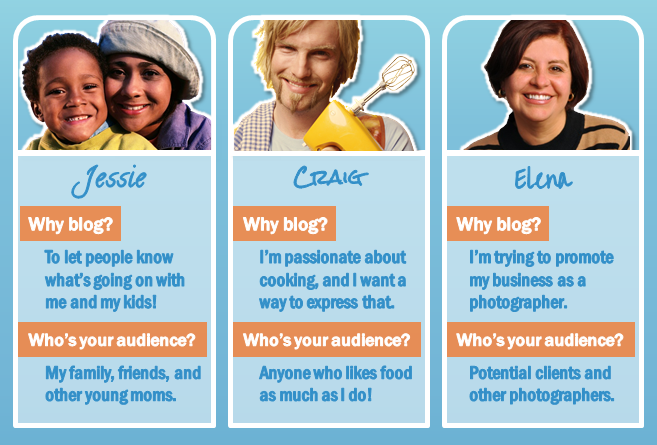
The main reason you want to start blogging is your primary goal. However, most people have more than one reason for blogging. These extra reasons are your secondary goals. Examining your primary goal and your desired audience can help you identify your secondary goals.
For example, as you can see from the image above, Jessie's primary goal is to keep her friends and family updated about her kids. However, the blog is not just for those people—she says she'd also like for other moms to read her blog. So one of her secondary goals might be to:
If she's interested in having a lot of people read her writing, she might also have this common secondary goal:
In short, anything that motivates you to blog, no matter how minor, can be one of your blogging goals. As you develop your blog, keeping your goals in mind will help you decide exactly what you want your blog to be like.
One of the biggest factors in your blog's success is having a topic you find interesting. After all, blogging is something you'll be doing in your spare time, so how much you write will largely depend on how much you enjoy it. Having a topic you like will make keeping up with your blog easier and more rewarding.
One way to test whether or not you've chosen a good topic is to think of potential posts that fit that topic. You may even want to make a list, similar to the one seen below.
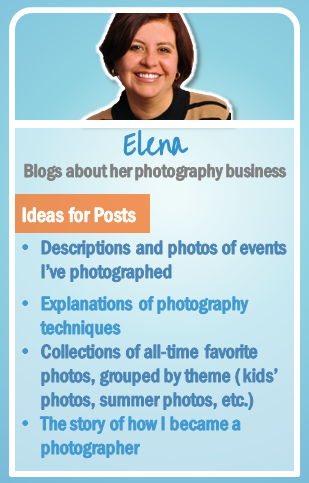
Remember, you don't have to commit to writing any of the posts that you come up with. You're just exploring your topic to see if you're interested in it enough to blog about it over the long term. If you have trouble coming up with ideas for posts, you may want to reconsider or adjust your topic.
If you chose to write about a broad topic, you might consider narrowing it down to a smaller one. This can help you keep focused on the topics you're most interested in. It may also make your blog stand out from other, more general blogs.
One way to narrow down your blog's focus is to think of subjects that fall within the scope of your overall topic. These subjects are potential subtopics. Are there any that particularly interest you or seem like they'd be easy to write about? You might consider focusing mainly on one or two of those subtopics.
Review the image below to see how Craig narrowed down the focus of his cooking and food blog to two narrow subtopics: recipes and cooking tips.
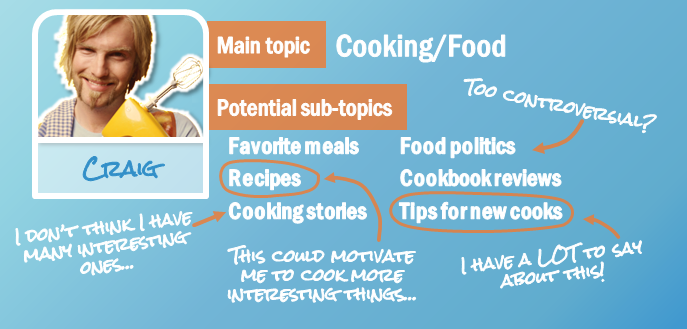
Some people prefer to blog without limiting themselves to a few related topics. Instead, they write "lifestyle" blogs that cover a range of subjects that interest them, including their own lives. A lifestyle blogger might write about a personal experience in one post, then review products in the next.
For instance, Jessie, who started a blog about her kids, could later decide to expand her blog's focus to include other topics. She might write about her personal life, as well as her hobbies and other things she's interested in, like fashion, crafts, and community issues. She could sort her posts on various subjects into categories so readers could easily find the posts that interest them.
Blogging this way can be fun because you can regularly write about anything that comes to your mind. That said, it does have a few drawbacks. It may be more difficult for you to attract readers who don't personally know you. Also, not all of your readers will be interested in all of the subjects you write about. This can be especially true if you mix personal posts with more polarizing, controversial ones. For example, readers who enjoy Jessie's posts about her kids may be turned off or even offended by some of her posts on sensitive subjects like politics.
It's difficult to get people to read your blog if you don't update it regularly. While it's easy to be enthusiastic about your blog and post frequently when you first get started, you may find it more challenging to keep up with posting as time goes on.
Having a posting schedule can make it easier to find time for your blog. How you create your schedule is up to you. Some people work best with a strict schedule and may prefer to set aside a little bit of time every day to work on their blogs. Others might be happier choosing a loose schedule. With this type of schedule, they might post twice a week but not always on the same day or at the same time.
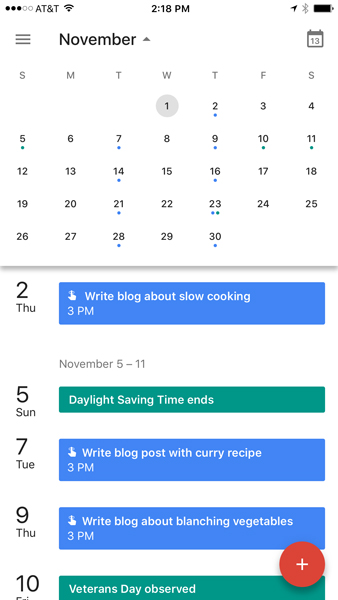
When you're deciding how much time you want to commit to your blog, make sure to consider all of your other commitments, and be realistic about the amount of time you actually want to spend writing. Remember, blogging is a hobby. If you treat it too much like a chore, it may become less enjoyable.
You can also manage your time by writing drafts of your blog posts ahead of time, then posting them at a later date. Most blog services even include a feature that lets you schedule saved posts. Once you've scheduled a post, it will automatically be published at the time you specified. Scheduling posts can be a good way to guarantee that you post about the same number of updates each week.
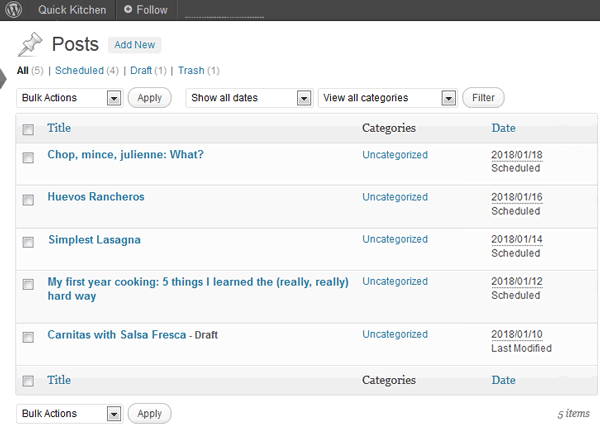
These drafts and scheduling tools can be especially useful if you find it difficult to set aside a particular time of day for writing. You can create drafts when you have a lot to write about and post them later, when you're feeling too busy or uninspired to write.
Before you write your first blog post, you should already know how personal you want your blog to be. Some bloggers choose to blog with their real names and include personal details about their lives. Others blog with a pseudonym, or fake name. If you're either a private or open person, the decision on whether or not to reveal personal information on your blog probably seems pretty straightforward. However, there are a few things everyone should consider when deciding how much to share.
Review the graphic to learn about the pros and cons of sharing personal details on your blog.
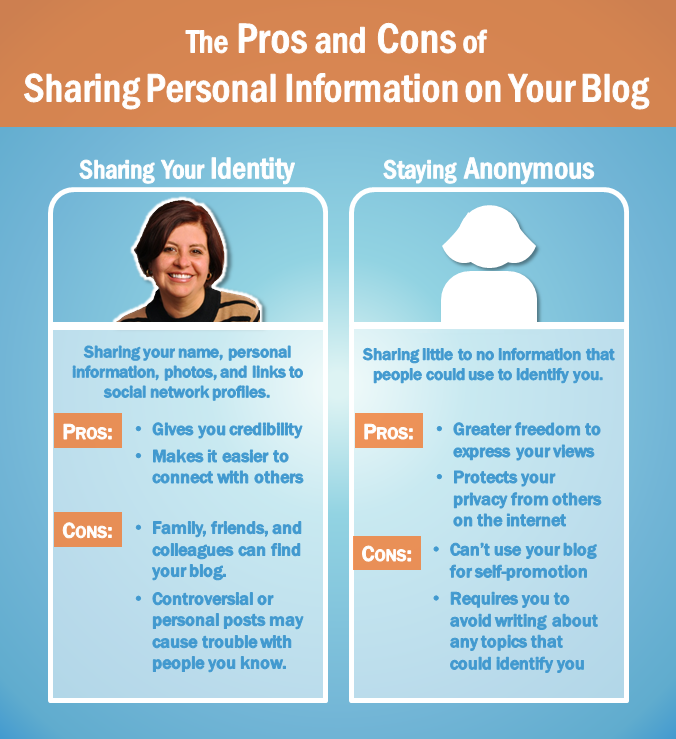
Now that you understand the pros and cons of sharing personal information on your blog, look back at your blogging goals and the audience you decided to write for. Depending on how you're going to use your blog, you might have to share at least a little information in order to reach your goals.
For example, if you're like Elena and want to use your blog to promote yourself or build a career, you'll need to include at least some personal information. You don't have to include many personal details—just enough that someone looking to learn about your work would be able to find your blog and get in touch with you if necessary.

On the other hand, if you have a more personal blog you may not want to link real-life information like your full name and location to the things you write. In Jessie's case, there's no real need to share identifying information on her blog. Her main audience is her family and friends, who already know who she is.

Whether you choose to make your identity public or be completely anonymous, you should be cautious about sharing personal details online. As you decide how much you feel comfortable sharing, keep this in mind: Once you post information about yourself online, it's almost impossible to be totally anonymous later, even if you remove the information you shared.
Unless you're like Elena and have a real need to share personal details, we recommend starting out by sharing a minimal amount of information about yourself. As you get more comfortable blogging, you may choose to share more about yourself with your readers.

Before you share any kind of personal information on your blog or other social media, it's important to make sure that you're not compromising your safety. For more information, check out our Social Media Privacy Basics lesson from our Internet Safety tutorial.
Much of your blog's design will depend on the blog service you choose to host it. It's difficult to plan the appearance of your blog in too much detail before you've actually signed up with a blog service. However, there are a few components of your blog's design that you can decide on ahead of time.
Your blog name is important because it's the first thing people will see about your blog. There's no single rule or formula for coming up with a good blog name, but these tips can help:
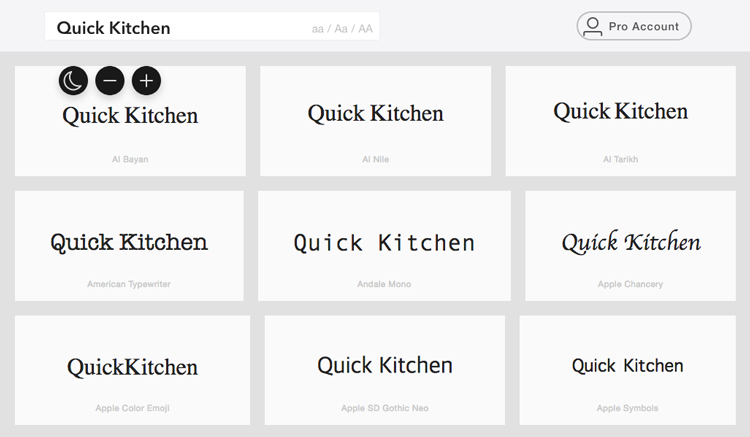
As mentioned above, you'll get to customize the appearance of your blog when you create it with a blog service. Most major blog services offer various themes, or templates, you can use to select the layout of your blog. Once you choose a template, you can further customize its appearance by choosing a new color scheme and organizing your posts into categories.
Making choices about your blog's appearance will be easier if you already have an idea about how you want your blog to look. Look at blogs that you find visually appealing. Ideally, these blogs should also have similar subject matter to your own—after all, a design that works for a political blog may look strange on a photoblog. However, this isn't essential. You can use any blogs you like as design inspiration.
Once you've found blogs whose design you like, the next step is to figure out what they have in common. You can then use those design elements in your own blog.
For an example of this process, review Elena's design inspirations in the graphic below.
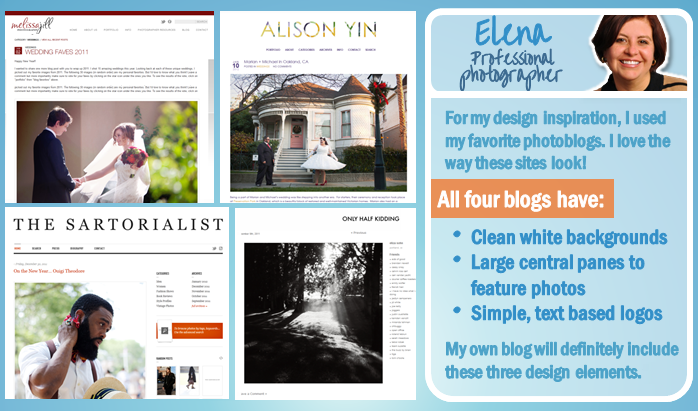
/en/blogbasics/choosing-a-blog-service/content/